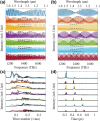Photon coupling-induced spectrum envelope modulation in the coupled resonators from Vernier effect to harmonic Vernier effect
- PMID: 39634476
- PMCID: PMC11501918
- DOI: 10.1515/nanoph-2021-0596
Photon coupling-induced spectrum envelope modulation in the coupled resonators from Vernier effect to harmonic Vernier effect
Abstract
The Vernier effect and harmonic Vernier effect have attracted ever-increasing interest due to their freely tailored spectrum envelope in tunable laser, modulator, and precision sensing. Most explorations have mainly focused on configuring two isolated optical resonators, namely the reference and tunable resonator. However, this configuration requires a stable reference resonator to guarantee robust readout, posing a significant challenge in applications. Here, we discover the coupled-resonators configuration enabling a reference-free envelope modulation to address this problem. Specifically, all parameters of one resonator theoretically span a hypersurface. When the resonator couples to another one, photon coupling merit an escaped solution from the hypersurface, resulting in an envelope modulation independent of reference. We have first experimentally verified this mechanism in a coupled air resonator and polydimethylsiloxane resonator by inserting a semi-transparent 2-mercaptobenzimidazole-modified silver nanowire network. In addition, this novel mechanism provides a new degree of freedom in the reciprocal space, suggesting alternative multiplexing to combine more envelope modulations simultaneously. This study facilitates the fundamental research in envelope multiplexing. More importantly, the combination of silver nanowire network and flexible microcavity experimentally progress the spectral envelope modulation in optoelectronic integration inside resonators.
Keywords: Vernier effect and harmonic Vernier effect; envelope multiplexing modulation; photon coupling; reference-free envelope modulation; silver nanowire.
© 2022 Lei Chen et al., published by De Gruyter, Berlin/Boston.
Figures





References
-
- Troia B., De Leonardis F., Passaro V. M. N. Cascaded ring resonator and Mach-Zehnder interferometer with a Sagnac loop for Vernier-effect refractive index sensing. Sensor. Actuator. B Chem. . 2017;240:76–89. doi: 10.1016/j.snb.2016.08.095. - DOI
-
- Robalinho P. M. R., Gomes A. D., Frazão O. High enhancement strain sensor based on Vernier effect using 2-Fiber loop mirrors. IEEE Photon. Technol. Lett. . 2020;32:1139–1142. doi: 10.1109/lpt.2020.3014695. - DOI
LinkOut - more resources
Full Text Sources
